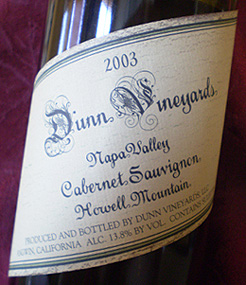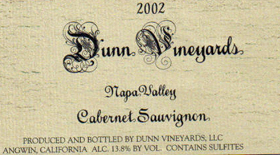

Randy Dunn's wake-up letter to consumers and wine reviewers is a result of his frustration with market-driven high alcohol wines.
Howell Mountain ~ Napa Valley (AVA)
Winemaker Randy Dunn:
‘Higher alcohol wines should stop.'
Did you hear the one about what one wine bottle said to the other:
“Boy, it’s sure getting hot in here!”
by
Alan Goldfarb
July 27, 2007
The other day Randy Dunn had just gotten through blending his Howell Mountain Cabernet Sauvignon from the 2004 vintage. It came in at 14.1 percent alcohol. More precisely, make that 14.11. It was the first time in Dunn's 28 years of making wine in the Napa Valley that one of his wines broke the 14-point barrier.
So, what did Randy Dunn, the owner of his eponymous Dunn Vineyards do? He sent out a letter (Click here to read letter) in the form of an e-mail to the media calling for a cessation of all wines that have alcohol levels over 15-percent.
Dunn, who said it took him more than a year to finish the letter, began his diatribe thusly: “It is time for the average wine consumer, as opposed to tasters, to speak up. The current fad of higher and higher alcohol wines should stop. Most wine drinkers do not really appreciate wines that are 15-, 16-plus percent alcohol. They are, in fact, hot and very difficult to enjoy with a meal.”
Further he wrote: “Influential members of the wine press have led the score-chasing winemakers/owners up the alcohol curve and now I hope that it soon will lead them down.”
Dunn, 61, who has been making wine since 1979, insists that his Howell Mountain Cabernets, in spite of the 14.11 anomaly, which he calls “an accident,” have “consistently come in between 13.2-13.8 percent alcohol since 1979.” But he says his colleagues are making what he describes as “cigar wines,” which he says are “made for standing and not sitting down with a meal. I hate to see the whole industry cater to that segment of the population and there’s a whole bunch of the population that likes to drink wines that are not just sipping and sitting wines,” is the way he puts it.
says are “made for standing and not sitting down with a meal. I hate to see the whole industry cater to that segment of the population and there’s a whole bunch of the population that likes to drink wines that are not just sipping and sitting wines,” is the way he puts it.
So, what caused him to write such a letter, which is sure to get some of his colleagues’ backs up; not to mention those critics who he thinks have driven the market toward high-alcohol wines?
“It was prompted by a conversation that I had with a wine writer, who asked point blank, “How do you keep your alcohol so low?’ I said, ‘You led the consumer up the alcohol curve and like puppy dogs, you’re going to lead them back down.’”
Dunn isn’t the only highly visible critic of such wines. In recent weeks, Sacramento wine merchant Darrell Corti has ceased selling wines in his grocery that are higher than 14.5 alcohol.
With regard to Corti's stand, Dunn says, “I think it’s great” and confides that he called to read a draft of his letter to Corti. In turn, he said Corti approved of his letter. “I think he wants some company,” laughs Dunn, commenting on their mutual opposition to the wines that have been so trendy in recent years.
Will that trend ever come to an end; and will winemakers ever go back to making wines that are more in balance and therefore, lower in alcohol? Dunn believes he has an idea, which might be the underlying motive for his missive. He thinks that there is a place for those wines in question, but that critics should separate them out and place them in a kind of category of their own.
“Splitting the reviews would help out everybody,” he contends. “It would help those who want guidance for their lower alcohol wines and it would help those that would want higher alcohol wines. Where would that number be? I don’t know, maybe before 15. “My letter was not at all attacking any reviewers. It was for the industry. …”
When told that it’s a belief that many consumers couldn’t give a fig about wines with food, and that they want wines to sip and taste; and the higher the alcohol the better, Dunn responds, “I have heard that there are some people (that) for that very reason are misstating the alcohol level on their labels, and cheating upwards.” What else are his colleagues up to? What does he mean when he writes about the “vogue for physiologically mature” wines? And is “physiologically mature” a rubric for allowing the sugar levels to climb?
“It’s a stroke. People want to make wines of high alcohol, and now they’re walkin’ the walk and talkin’ the talk and they’ve invented this ‘physiological maturity’ term to help them justify it,” he declares. “… Now ‘physiological maturity’ is at a higher level than it used to be.
His response has more to do with terroir and appellation differences. “In those days it was relatively easy to distinguish a Rutherford Cab from a Stags Leap, a Howell, or a St. Helena. It wasn’t rocket science. Now, because they pick so ripe, the wines all have melded together and the nuances are gone. That’s why the whole terroir business and sub-appellations are getting very diluted. The only way they’re going to get back to differences is get back to lower alcohol wines.”
a Rutherford Cab from a Stags Leap, a Howell, or a St. Helena. It wasn’t rocket science. Now, because they pick so ripe, the wines all have melded together and the nuances are gone. That’s why the whole terroir business and sub-appellations are getting very diluted. The only way they’re going to get back to differences is get back to lower alcohol wines.”
But some think that Dunn is casting stones when he has been notorious for making wines that are not approachable at an early age because they are high in tannins. What’s the difference?
“There’s a big difference because the flavors are different, the age-ability factor is different,” he contends. “The people who appreciate my wine appreciate the fact that it has some years of bottle age on it and gives them something special in years to come.”
And what about the critics such as those at the Wine Spectator and The Wine Advocate. who have given him high scores over the years. Will he continue to be their darling after his letter generates the debate it’s sure to engender?
“It will be interesting to see,” he says matter-of-factly. “(But) they know its true (his contentions); that’s something that they have to deal with. …”
Does he really believe consumers, who he calls on to respond to those high alcohol wines, will become proactive in this debate?
“It’s worth a shot,” he says adding, “if they don’t like what’s going on and they don’t do something, it's their own damned fault.”
Finally, does he have any regrets that he sent the letter?
“I’m glad I did it,” he retorts. “Whether or not I can say that in six months, I guess we’ll find out. … I think that everybody can win, which is the important part.”
The following is the e-mail Randy Dunn sent to media members:
So, what did Randy Dunn, the owner of his eponymous Dunn Vineyards do? He sent out a letter (Click here to read letter) in the form of an e-mail to the media calling for a cessation of all wines that have alcohol levels over 15-percent.
Dunn, who said it took him more than a year to finish the letter, began his diatribe thusly: “It is time for the average wine consumer, as opposed to tasters, to speak up. The current fad of higher and higher alcohol wines should stop. Most wine drinkers do not really appreciate wines that are 15-, 16-plus percent alcohol. They are, in fact, hot and very difficult to enjoy with a meal.”
Further he wrote: “Influential members of the wine press have led the score-chasing winemakers/owners up the alcohol curve and now I hope that it soon will lead them down.”
Dunn, 61, who has been making wine since 1979, insists that his Howell Mountain Cabernets, in spite of the 14.11 anomaly, which he calls “an accident,” have “consistently come in between 13.2-13.8 percent alcohol since 1979.” But he says his colleagues are making what he describes as “cigar wines,” which he
 says are “made for standing and not sitting down with a meal. I hate to see the whole industry cater to that segment of the population and there’s a whole bunch of the population that likes to drink wines that are not just sipping and sitting wines,” is the way he puts it.
says are “made for standing and not sitting down with a meal. I hate to see the whole industry cater to that segment of the population and there’s a whole bunch of the population that likes to drink wines that are not just sipping and sitting wines,” is the way he puts it.
So, what caused him to write such a letter, which is sure to get some of his colleagues’ backs up; not to mention those critics who he thinks have driven the market toward high-alcohol wines?
“It was prompted by a conversation that I had with a wine writer, who asked point blank, “How do you keep your alcohol so low?’ I said, ‘You led the consumer up the alcohol curve and like puppy dogs, you’re going to lead them back down.’”
Dunn isn’t the only highly visible critic of such wines. In recent weeks, Sacramento wine merchant Darrell Corti has ceased selling wines in his grocery that are higher than 14.5 alcohol.
With regard to Corti's stand, Dunn says, “I think it’s great” and confides that he called to read a draft of his letter to Corti. In turn, he said Corti approved of his letter. “I think he wants some company,” laughs Dunn, commenting on their mutual opposition to the wines that have been so trendy in recent years.
Will that trend ever come to an end; and will winemakers ever go back to making wines that are more in balance and therefore, lower in alcohol? Dunn believes he has an idea, which might be the underlying motive for his missive. He thinks that there is a place for those wines in question, but that critics should separate them out and place them in a kind of category of their own.
“Splitting the reviews would help out everybody,” he contends. “It would help those who want guidance for their lower alcohol wines and it would help those that would want higher alcohol wines. Where would that number be? I don’t know, maybe before 15. “My letter was not at all attacking any reviewers. It was for the industry. …”
When told that it’s a belief that many consumers couldn’t give a fig about wines with food, and that they want wines to sip and taste; and the higher the alcohol the better, Dunn responds, “I have heard that there are some people (that) for that very reason are misstating the alcohol level on their labels, and cheating upwards.” What else are his colleagues up to? What does he mean when he writes about the “vogue for physiologically mature” wines? And is “physiologically mature” a rubric for allowing the sugar levels to climb?
“It’s a stroke. People want to make wines of high alcohol, and now they’re walkin’ the walk and talkin’ the talk and they’ve invented this ‘physiological maturity’ term to help them justify it,” he declares. “… Now ‘physiological maturity’ is at a higher level than it used to be.
“Why do you have to call it mature when it’s overripe?”
Dunn, who says he usually picks his grapes between 23.5-to-25 Brix, is asked why so many of his fellow winemakers seem obsessed about getting the herbaceous-ness out of their wines, when that characteristic was a favorable one in the 1970s and ‘80s and not a pejorative as it is today?His response has more to do with terroir and appellation differences. “In those days it was relatively easy to distinguish
 a Rutherford Cab from a Stags Leap, a Howell, or a St. Helena. It wasn’t rocket science. Now, because they pick so ripe, the wines all have melded together and the nuances are gone. That’s why the whole terroir business and sub-appellations are getting very diluted. The only way they’re going to get back to differences is get back to lower alcohol wines.”
a Rutherford Cab from a Stags Leap, a Howell, or a St. Helena. It wasn’t rocket science. Now, because they pick so ripe, the wines all have melded together and the nuances are gone. That’s why the whole terroir business and sub-appellations are getting very diluted. The only way they’re going to get back to differences is get back to lower alcohol wines.”
But some think that Dunn is casting stones when he has been notorious for making wines that are not approachable at an early age because they are high in tannins. What’s the difference?
“There’s a big difference because the flavors are different, the age-ability factor is different,” he contends. “The people who appreciate my wine appreciate the fact that it has some years of bottle age on it and gives them something special in years to come.”
And what about the critics such as those at the Wine Spectator and The Wine Advocate. who have given him high scores over the years. Will he continue to be their darling after his letter generates the debate it’s sure to engender?
“It will be interesting to see,” he says matter-of-factly. “(But) they know its true (his contentions); that’s something that they have to deal with. …”
Does he really believe consumers, who he calls on to respond to those high alcohol wines, will become proactive in this debate?
“It’s worth a shot,” he says adding, “if they don’t like what’s going on and they don’t do something, it's their own damned fault.”
Finally, does he have any regrets that he sent the letter?
“I’m glad I did it,” he retorts. “Whether or not I can say that in six months, I guess we’ll find out. … I think that everybody can win, which is the important part.”
The following is the e-mail Randy Dunn sent to media members:
Date: July 24, 2007 1:06:11 PM PDT
Subject: Letter from Randy Dunn regarding alcohol levels in today's wines
It is time for the average wine consumers, as opposed to tasters, to speak up. The current fad of higher and higher alcohol wines should stop. Most wine drinkers do not really apprec










 READER FEEDBACK: To post your comments on this story,
READER FEEDBACK: To post your comments on this story,




